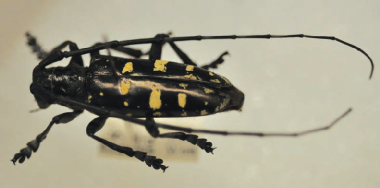Cornell bids farewell to its premier insect sleuth
Cornell bids farewell to its premier insect sleuth
Beetles that gnaw out of hidey-holes in wooden cuckoo clocks after lying dormant for more than a dozen years; bits of skin from phobic folks who think bugs are crawling all over them; mouse poop, fur balls, and sweater lint misidentified as insect eggs or body parts; tick heads, cockroach bits, and bed bugs squashed to bloody smithereens.
Those are just a few of the oddities that went under Carolyn Klass's dissecting microscope during her four-decades-long stint as the Miss Marple of Cornell Cooperative Extension's Insect Diagnostic Laboratory. But those days are over, as Klass '71 retired in January. Her departure creates a major void for the homeowners, master gardeners, and Ag and Market reps who have relied on Klass's pest-identification expertise since the lab opened in 1971. It was Klass who handled the first specimen of the dreaded Asian longhorned beetle sent from Brooklyn in 1996. Last year, she identified the leek moth, scourge of American and Canadian leek crops.

Klass, who still stops by her office once a week, long shared the cramped Comstock Hall lab with other researchers. She moves with ease in the tight space, holding up a jar of European crane flies (bane of golf courses in their larval stage) for the inquiring photographer, or pulling out a display rack of carefully identified species—cockroaches, bed bugs, and beetles, pinned in place. Here and there stand vials and jars that contain the luckless husks of many an insect past. Piles of fact sheets spill onto an examination table next to the major tools of her trade: two fiber-optic light-dissecting microscopes.
Klass grew up in Rockland County, where her parents were avid gardeners; over time, she learned that the jewel-like Japanese beetle was a rose blossom's assassin, and that carpenter ants didn't build houses, they ate them. Still, she found insects pretty cool—living reminders that even in a cozy suburb, it's a jungle out there. "Children are naturally fascinated by insects," she says. "I guess I was no different, really—with the exception that my passion became my vocation."

Klass was recently featured in the New Yorker's Talk of the Town section, in a story that focused on her work identifying bed bugs. "Bed bugs weren't a big deal when I started here," she says. "But that's changed quite a bit over the years." While charmed by the New Yorker piece, Klass points out that profiling bed bugs was just one small part of her job. In addition to her insect-identification duties, she delivered hundreds of talks to 4-H groups as well as to master gardeners and state and private pest control agencies. Entomology department chair Jeff Scott said he recently fielded two requests for Klass to speak. "I had to tell them she's not available any longer," he laments. "They were pretty sad to hear the news. I'm sad she's leaving, too."

It's unclear if anyone will replace Klass or if the Insect Diagnostic Laboratory will endure. This is no small matter: with the Cornell imprimatur behind her, Klass was the state's leading authority on insect pest queries and management. She performed the vital sleuthing needed to identify an apple maggot or a rhubarb curculio or the fiendish oak skeletonizer and published fact sheets on dozens of pests. Samples continue to arrive at the lab representing every household and outdoor bug imaginable, from stinging insects to termites to the pests that bedevil gardeners.
While other land-grant schools offer similar services, Klass was in a class by herself, says senior Extension associate Rick Hoebeke. "She is a phenomenal expert in the field; there's no one like her," he says. "I just got a call from a Cooperative Extension agent in Ontario County who was distraught over her departure. He asked, 'Who's gonna help us now?'"
— Franklin Crawford


